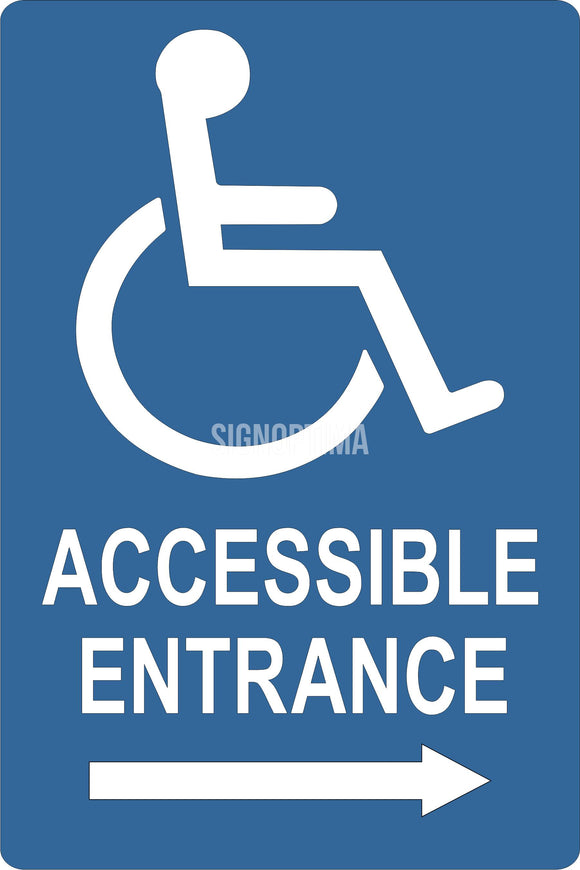ADA Signs: Ensuring Access and Compliance in Public Spaces
ADA signs plays a crucial role in guaranteeing access and compliance within public areas, significantly contributing to a comprehensive atmosphere for people with impairments. By sticking to ADA criteria, signage not only promotes navigation however additionally underscores an organization's devotion to variety and equality. As we explore the subtleties of ADA signs, from responsive features to create details, it's essential to consider exactly how these components integrate to copyright the rights of all individuals. What are the usual mistakes organizations deal with in preserving conformity, and just how can future fads in signs remain to drive availability ahead?
Relevance of ADA Signs
In modern culture, the value of ADA signs prolongs beyond simple compliance with legal mandates to embody a commitment to inclusivity and accessibility for all people. These indications are necessary in producing atmospheres where individuals with disabilities can browse public rooms with the exact same simplicity and independence as those without handicaps. By giving clear and standard information, ADA signs makes sure that everybody can access facilities, solutions, and info without barriers.
The importance of ADA signs exists in its ability to improve the lifestyle for people with disabilities by advertising equal accessibility. It gets rid of the obstacles that could or else impede their capacity to take part fully in neighborhood life. Additionally, these indicators work as visible signs of an organization's devotion to diversity and equal rights, reflecting wider societal worths that champion the legal rights and dignity of all individuals.
Additionally, ADA signs plays a vital role in public security. By leading individuals to departures, restrooms, and other essential centers, it makes sure that all individuals, no matter physical capability, can leave securely during emergencies. In summary, ADA signs is not simply a governing requirement but a powerful device for promoting a inclusive and equitable culture.
Trick Elements of Compliance

Positioning is vital; indications should be set up in locations that are obtainable and easily visible. Usually, signage ought to be mounted between 48 and 60 inches from the ground to ensure accessibility for both standing and wheelchair users. Tactile components, such as Braille, are crucial for people with visual impairments, giving important details in a non-visual style.
High-contrast colors in between the message and background are required to improve readability for individuals with reduced vision. The ADA mandates certain contrast ratios to make certain quality. Additionally, character dimension is a key factor to consider, with minimum elevation demands dictated by the checking out range to make sure readability from various angles.
Design Factors To Consider for Access
Creating available signs calls for a meticulous approach to guarantee it fulfills the demands of all customers, especially those with impairments. The size of the text is similarly crucial, with ADA standards advising a minimal height based on seeing distance to make sure clarity.
Contrasting shades between text and history are crucial for exposure, particularly for individuals with visual impairments. Furthermore, tactile aspects, such as Braille and increased personalities, are essential for people who are blind or have reduced vision.
Furthermore, the positioning of signs plays a considerable function in accessibility. Indicators need to be installed in places that are unblocked and conveniently reachable. Ensuring that signs is mounted at suitable elevations and angles makes it possible for all users, consisting of those making use of wheelchairs, to interact with them successfully.
Typical Mistakes to Stay Clear Of

Another prevalent mistake is the inaccurate positioning of signage. ADA guidelines specify accurate height try this and area demands to ensure that signs are conveniently visible and obtainable by all people, consisting of those using wheelchairs. image source Ignoring these guidelines not just hampers availability yet additionally risks non-compliance with lawful criteria.
Additionally, not enough contrast in between message and background is a constant oversight. Sufficient contrast is vital for readability, especially for individuals with reduced vision. Designers in some cases select shades that are aesthetically enticing but lack the required contrast, making the text challenging to determine.
Lastly, some developers fall short to include tactile components, such as Braille, which are essential for people who are blind. Leaving out these attributes not just leads to non-compliance with ADA laws yet likewise restricts access for a sector of the population that depends on tactile information.
Future Trends in Signage
Developments in technology and boosting recognition of inclusivity are forming the future fads in signs style. As culture ends up being a lot more aware of varied demands, the assimilation of clever modern technologies into signage is acquiring traction. Digital signage, for example, is evolving to consist of interactive features and real-time updates, which Check Out Your URL can be crucial in supplying vibrant info in public areas. These signs frequently incorporate touch screens or gesture-based controls, enabling users to browse material tailored to their particular requirements.
One more arising pattern is the utilization of enhanced reality (AR) to improve user experience. AR-enabled signs can overlay electronic info onto the physical setting, giving aesthetically damaged individuals with auditory or haptic responses. ADA Signs. This innovation not only enhances ease of access yet also develops an engaging experience for all individuals
Sustainability is additionally a significant variable influencing signs trends. Green materials and energy-efficient illumination remedies are being prioritized to line up with international ecological goals. Advancements in materials science are leading to the advancement of even more durable and weather-resistant indications.
Final Thought
ADA signs plays a vital function in guaranteeing ease of access and conformity within public rooms by including responsive elements, high-contrast colors, and calculated positioning. The adherence to ADA criteria not just promotes secure navigating for people with handicaps however additionally indicates a company's devotion to variety and inclusivity. By staying clear of typical errors and accepting future patterns, public areas can remain to advance these values, guaranteeing that the rights and dignity of all people are valued and promoted.
ADA signs plays an essential role in guaranteeing accessibility and conformity within public rooms, substantially contributing to an inclusive environment for individuals with handicaps. As we discover the subtleties of ADA signage, from responsive attributes to create complexities, it's essential to take into consideration just how these components coalesce to copyright the civil liberties of all individuals.In contemporary culture, the relevance of ADA signs extends past simple compliance with lawful mandates to personify a dedication to inclusivity and ease of access for all people. By offering standard and clear info, ADA signs makes sure that everyone can access centers, services, and details without obstacles.
ADA signage plays a crucial role in assuring ease of access and conformity within public spaces by including tactile elements, high-contrast shades, and strategic positioning. (ADA Signs)